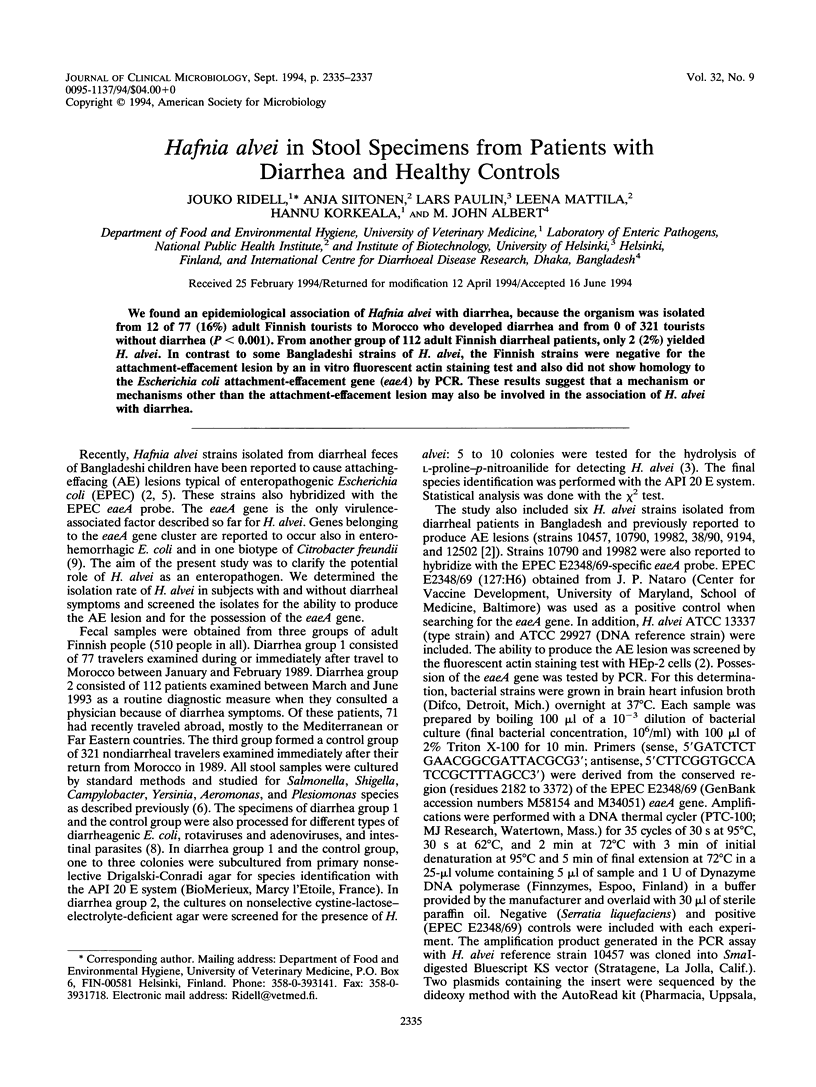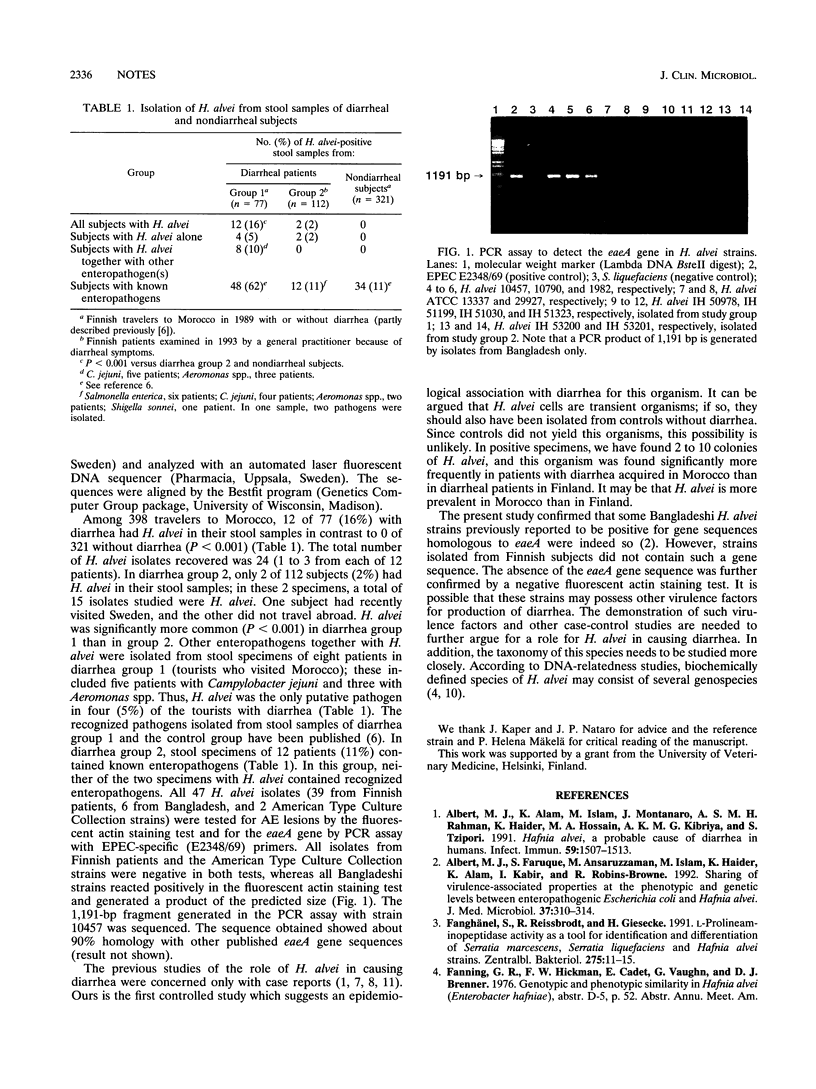Abstract
We found an epidemiological association of Hafnia alvei with diarrhea, because the organism was isolated from 12 of 77 (16%) adult Finnish tourists to Morocco who developed diarrhea and from 0 of 321 tourists without diarrhea (P < 0.001). From another group of 112 adult Finnish diarrheal patients, only 2 (2%) yielded H. alvei. In contrast to some Bangladeshi strains of H. alvei, the Finnish strains were negative for the attachment-effacement lesion by an in vitro fluorescent acting staining test and also did not show homology to the Escherichia coli attachment-effacement gene (eaeA) by PCR. These results suggest that a mechanism or mechanisms other than the attachment-effacement lesion may also be involved in the association of H. alvei with diarrhea.
Full text
PDF


Images in this article
Selected References
These references are in PubMed. This may not be the complete list of references from this article.
- Albert M. J., Alam K., Islam M., Montanaro J., Rahaman A. S., Haider K., Hossain M. A., Kibriya A. K., Tzipori S. Hafnia alvei, a probable cause of diarrhea in humans. Infect Immun. 1991 Apr;59(4):1507–1513. doi: 10.1128/iai.59.4.1507-1513.1991. [DOI] [PMC free article] [PubMed] [Google Scholar]
- Albert M. J., Faruque S. M., Ansaruzzaman M., Islam M. M., Haider K., Alam K., Kabir I., Robins-Browne R. Sharing of virulence-associated properties at the phenotypic and genetic levels between enteropathogenic Escherichia coli and Hafnia alvei. J Med Microbiol. 1992 Nov;37(5):310–314. doi: 10.1099/00222615-37-5-310. [DOI] [PubMed] [Google Scholar]
- Fanghänel S., Reissbrodt R., Giesecke H. L-prolineaminopeptidase activity as a tool for identification and differentiation of Serratia marcescens, Serratia liquefaciens and Hafnia alvei strains. Zentralbl Bakteriol. 1991 Apr;275(1):11–15. doi: 10.1016/s0934-8840(11)80763-2. [DOI] [PubMed] [Google Scholar]
- Jerse A. E., Yu J., Tall B. D., Kaper J. B. A genetic locus of enteropathogenic Escherichia coli necessary for the production of attaching and effacing lesions on tissue culture cells. Proc Natl Acad Sci U S A. 1990 Oct;87(20):7839–7843. doi: 10.1073/pnas.87.20.7839. [DOI] [PMC free article] [PubMed] [Google Scholar]
- Mattila L., Siitonen A., Kyrönseppä H., Simula I., Oksanen P., Stenvik M., Salo P., Peltola H. Seasonal variation in etiology of travelers' diarrhea. Finnish-Moroccan Study Group. J Infect Dis. 1992 Feb;165(2):385–388. doi: 10.1093/infdis/165.2.385. [DOI] [PubMed] [Google Scholar]
- Ratnam S. Etiologic role of Hafnia alvei in human diarrheal illness. Infect Immun. 1991 Dec;59(12):4744–4745. doi: 10.1128/iai.59.12.4744-4745.1991. [DOI] [PMC free article] [PubMed] [Google Scholar]
- Reina J., Hervas J., Borrell N. Acute gastroenteritis caused by Hafnia alvei in children. Clin Infect Dis. 1993 Mar;16(3):443–443. doi: 10.1093/clind/16.3.443. [DOI] [PubMed] [Google Scholar]
- Schauer D. B., Falkow S. The eae gene of Citrobacter freundii biotype 4280 is necessary for colonization in transmissible murine colonic hyperplasia. Infect Immun. 1993 Nov;61(11):4654–4661. doi: 10.1128/iai.61.11.4654-4661.1993. [DOI] [PMC free article] [PubMed] [Google Scholar]
- Steigerwalt A. G., Fanning G. R., Fife-Asbury M. A., Brenner D. J. DNA relatedness among species of Enterobacter and Serratia. Can J Microbiol. 1976 Feb;22(2):121–137. doi: 10.1139/m76-018. [DOI] [PubMed] [Google Scholar]
- Westblom T. U., Milligan T. W. Acute bacterial gastroenteritis caused by Hafnia alvei. Clin Infect Dis. 1992 Jun;14(6):1271–1272. doi: 10.1093/clinids/14.6.1271. [DOI] [PubMed] [Google Scholar]



